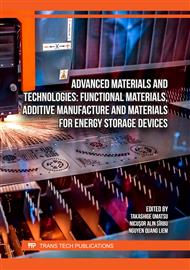p.3
p.9
p.17
p.23
p.31
p.39
p.45
p.51
3D-Printed Flexible Polyacrylamide/Alginate Gel Polymer Electrolyte for Zinc-Ion Batteries
Abstract:
Flexible and wearable electronics are increasingly popular and utilized in various forms. Batteries have become essential as an energy source for wearable electronics. To meet demands of such electronics, these batteries must remain flexible, lightweight, possess good electrochemical performance, customizable shape, and ensure safety. Zinc-ion batteries (ZIBs) have emerged as a promising energy source for these applications. However, ZIBs encounter challenges due to the lack of flexible electrolytes. Polyacrylamide (PAM) is a polymer widely used as gel polymer electrolytes (GPEs) owing to its versatile electrical conductivity and excellent flexibility. However, PAM alone lacks the mechanical strength required to support flexible and wearable electronics adequately. To address this limitation, alginate (Alg), a polysaccharide with good compatibility with PAM, is incorporated in varying concentrations (0-3 %wt.) to form interpenetrating networks (IPN) hydrogels, with a chemical network of PAM and a physical network of alginate to enhance the overall mechanical properties. Following this, the 3D-printed PAM/Alg hydrogels are immerged in a 2M ZnSO4 electrolyte to create PAM/Alg gel polymer electrolytes (PAM/Alg-GPEs). This process significantly improves the mechanical properties of PAM/Alg-GPEs. Subsequently, the ionic conductivity of these 3D-printed PAM/Alg-GPEs is evaluated using electrochemical impedance spectroscopy (EIS). The results demonstrate that PAM/Alg-GPEs exhibit the desired flexibility along with sufficient electrochemical performance, making them promising candidates for use as wearable electrolytes in zinc-ion batteries.
Info:
Periodical:
Pages:
23-28
Citation:
Online since:
October 2024
Keywords:
Price:
Сopyright:
© 2024 Trans Tech Publications Ltd. All Rights Reserved
Share:
Citation:



